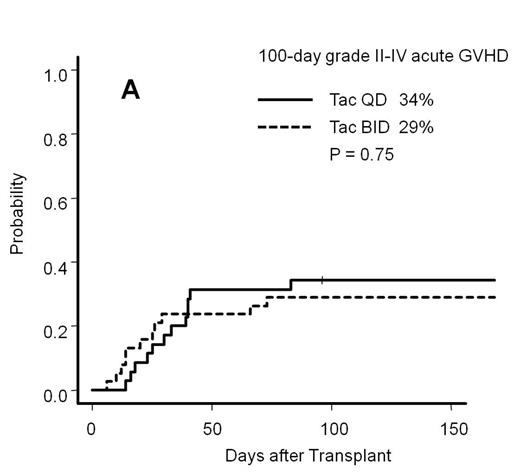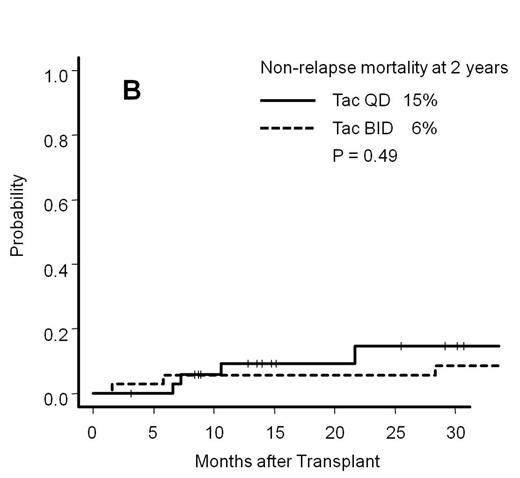Abstract
Background: Oral tacrolimus (Tac) was first developed as a twice-daily formulation (Tac BID) and has been widely used in solid organ and allogeneic hematopoietic stem cell transplantation (allo-SCT). Lifelong immunosuppression is required to preserve graft function after solid organ transplantation, and medical nonadherence of transplant recipients has been identified as a major cause of allograft failure. It has been well documented that frequent drug dosing affects patients' adherence. In response to this potential nonadherence problem, a once-daily modified release formulation of oral tacrolimus (Tac QD) has been developed. Results of randomized prospective phase III studies have indicated that Tac QD is well tolerated with similar efficacy and safety profiles as those of Tac BID in recipients after organ transplantation. Although Tac BID has been widely used in allo-SCT recipients, there are no available data on the use of Tac QD in this population. In this study, we compared retrospectively the efficacy of Tac QD versus Tac BID administration. The objective of this study was to investigate whether Tac QD is as effective as Tac BID in the setting of allo-SCT from unrelated donors.
Methods: The study cohort included 77 consecutive patients who received allogeneic bone marrow transplantation from unrelated donors for treatment of hematologic malignancies between 2000 and 2014: AML (n=35), ALL (n=15), CML (n=8), MDS (n=12), NHL (n=5), and MPN (n=2). Patients received Tac iv from day -1 with short-term methotrexate (MTX) on days 1, 3, 6, and 11; Tac iv was converted to either Tac QD (n=37) or Tac BID (n=40) when the patients were engrafted and could tolerate oral medication. Doses were modified to maintain a whole-blood trough concentration of 8-12 ng/ml. Tac BID was administrated until Oct 2008, and Tac QD was used from Nov 2008. Kaplan-Meier estimates were used for overall survival (OS), and cumulative incidence estimates were used for acute GVHD, chronic GVHD, and non-relapse mortality (NRM).
Results: Median age was 53 years (range: 23-66) for Tac QD cohorts and 39 years (range: 17-56) for Tac BID cohorts. Tac QD patients were older (P<0.01) and more likely to receive reduced intensity conditioning regimens (P<0.01) than Tac BID patients. The remaining other characteristics, namely, performance status, gender, disease stage, HLA disparity, and HCT-CI score, were evenly distributed between Tac QD and Tac BID cohorts. Median follow-up for survivors was 22 months in Tac QD cohorts and 111 months in Tac BID cohorts. Cumulative incidence of grade II-IV acute GVHD was 34% (95% CI, 19%-50%) for Tac QD cohorts and 29% (95% CI 16%-44%) for Tac BID cohorts (P=0.75). Incidence of grade III-IV acute GVHD was 6% (95% CI, 1%-17%) for Tac QD cohorts and 8% (95% CI 2%-20%) for Tac BID cohorts (P=0.67). There was no significant difference (P=0.23) in the incidence of chronic GVHD between Tac QD cohorts (33%, 95% CI, 18%-49%) and Tac BID cohorts (22%, 95% CI, 10%-37%). OS at 2 years was 62% (95% CI, 41%-78%) in Tac QD cohorts and 75% (95% CI 59%-86%) in Tac BID cohorts (P=0.58). The probability of developing NRM at 2 years was 15% (95% CI, 4%-32%) for Tac QD cohorts and 6% (95% CI 1%-17%) for Tac BID cohorts (P=0.49).
Conclusions: Although Tac QD cohorts included older patients than Tac BID cohorts, there was no difference in the risk of acute GVHD or chronic GVHD between Tac QD cohorts and BID cohorts. As Tac QD possibly contributes to reducing physical and mental stress for patients who need to take several different medications, our findings may indicate that the use of Tac QD for GVHD prophylaxis is beneficial for patients undergoing allo-SCT from unrelated donors.
No relevant conflicts of interest to declare.
Author notes
Asterisk with author names denotes non-ASH members.



This feature is available to Subscribers Only
Sign In or Create an Account Close Modal